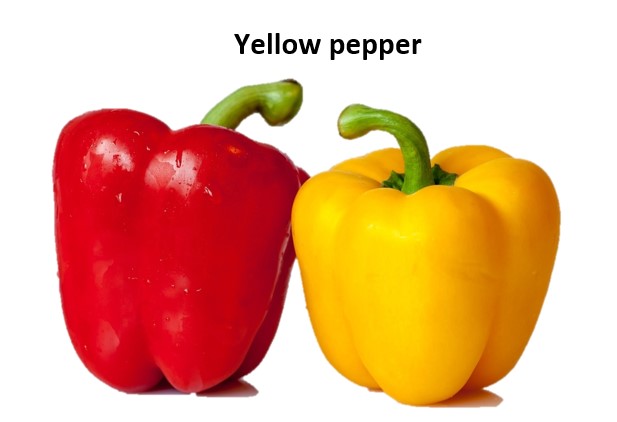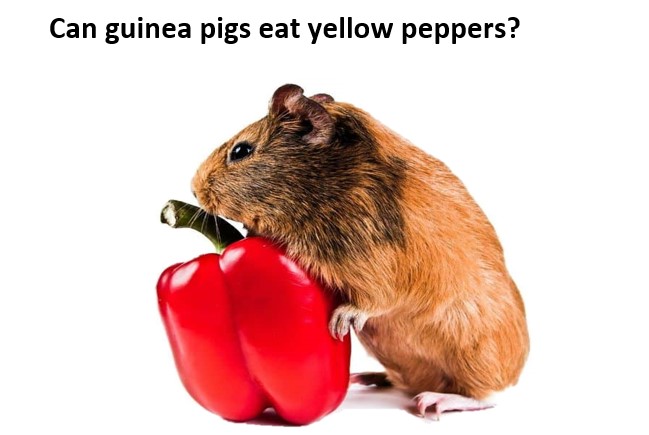One of the factors that would help in ensuring that guinea pigs are fit is by ensuring that they are provided with the right diet. Worry not, as a pet owner as to what maximum meals and nutrients you should offer your guinea pig.
So, the question still remains. Can guinea pigs eat yellow peppers? we will delve deeper into what be incorporated in a guinea pig’s diet, yellow peppers inclusive.
See also post :-Can Guinea Pigs Eat Chapati?
Nutritional content of yellow peppers
As previously stated, veggies like yellow bell peppers stand out due to their health benefits. Yes, you can include yellow peppers in the diet that you provide to your guinea pig but only within limits. Given below are the substances which can be found in abundance in yellow peppers.
Vitamin c: scurvy is a condition many guinea pigs can get and set higher amounts of yellow peppers to aid in reviving them the peppers are concentrated so will for guinea pigs they can’t make vitamin c in their bodies.
Vitamins a: helps with good eye sight skin repair and growth.
Dietary fiber: aids the function of the digestive system and general health of the intestines.
Antioxidants: includes beta-carotene and flavonoids that help reduce oxidative stress.
Fewer calories and less sugars: aside from grapefruits and apples, yellow peppers are regarded as a healthy snack owing to their low caloric content and reduced sugar content.
If you wish to give your guinea pig a healthy snack, then offering yellow peppers to your pet enhances his diet.
Can guinea pigs have yellow peppers?
Yes, yellow pepper can be consumed but the pepper should be fresh, raw and of course only in small amounts. Though, the following points should be kept in mind:
Seeds and stems: the yellow pepper seed will not be able to be digested by guinea pigs therefore do not serve them, however, the flesh can be safely fed to the guinea pigs.
Clean the peppers: you should always clean your peppers with soap and water, otherwise you would put your pet at risk because the surfaces of the peppers have pesticides and mud on them.
Moderation is key: what is advised though, is that more than small slices of yellow peppers should only be given very occasionally to guinea pigs in order to prevent them from experiencing digestive problems and other issues.
Health benefits of yellow peppers for guinea pigs
Inclusion of yellow peppers into their everyday diet offers some benefits for the guinea pigs:
Boosts immunity:
Because yellow peppers contain high levels of vitamin c, your guinea pig can be even less vulnerable to certain diseases.
Supports proper digestion and gut health
Yellow peppers are rich in fiber which is essential for healthy eating habits and can help with constipation prevention.
Uses high in beta-carotene as well as vitamin A
Yellow pepper do help to enhance the quality of the coat and skin of the guinea pig. As a bonus they also help to improve the vision of the pig, ensuring that they look and feel healthy.
Prevents scurvy
Moreover, a deficiency of well over a hundred milligrams in humans is equivalent to the guinea pigs’ having absolutely no vitamin c, hence while they are susceptible to such ailments, the yellow bell peppers serve to beat these disorders since they are nice to eat.
Restricts dehydration
This type of pepper is particularly helpful in combating dehydration because it contains high levels of water. This quality too has quite high use especially during the summer months.
Proper portions
Start with a thin slice of yellow pepper which is around 1-2cms in thickness. While ensuring the hamster’s tummy is not bulging due to eating too much, in this case gradually increase the dosage serving depending on the age and weight of the hamster and eventually ending up at around 2.5 times the initial dosage.
Frequency
In addition, yellow peppers can be given as an accessory to a meal on two or three occasions in a single week. Due to the fact that they could create imbalance due to the level of some nutrients these should not be given on a daily basis.
Preparation tips
- Make sure to wash the pepper carefully so there’s no pesticide residue left.
- We recommend slicing the pepper so it is more digestible and simple to chew.
- Make sure to take out the stem, and all seeds and other non-edible parts from the pepper since they are harmful for guinea pigs.
For serving, try not to cook the peppers because they lose a lot of nutrients while being cooked, so raw peppers should be included in a guinea pig diet.
Health risks involved in overfeeding yellow peppers
Despite the fact that yellow peppers are healthy, overfeeding them can have adverse effects. Some of health related risks include:
Stomach and digestive problems
Consuming too much of yellow peppers can cause issues like, bloating, diarrheic and other digestive issues as peppers contain a lot of water and have fibers.
Risk of nutrient deficiency
If yellow peppers are overused or relied upon, there is a risk of imbalance of other vitamins and essential minerals and nutrients.
High risk of chicken-ness
Yellow peppers have low calories but excessive feeding of any treat leads to weight increase and even to obesity at times.
To reduce chances of such health risks, yellow peppers must only be used in moderation and be made a part of other diets.
Other options besides yellow peppers
Some guinea pig safe vegetables that have similar nutritional values can be included if you wish to broaden you guinea pig’s daily meal plan.
Red bell peppers: stylistically wholesome alternatives possessing equal safety levels. Culminate delicious and cutting endowed with vitamin c in higher values the red peppers do stand over yellow peppers.
Green bell peppers: although muddled in rich nutrients and low calorific value still taste less sweet than their counterparts.
Carrots: they are one but a decent provider of beta carotene although because of their sweetness, moderation should be exercised during feeding.
Cucumbers: while not as voluminously nutrient dense as peppers but offer some hydration while replenishing with low calories.
Leafy greens: among the suitable options are kale, spinach, and romaine lettuce as they can provide a versatile range of vitamins and minerals.
Tips for a balanced guinea pig diet
As an essential food type yellow peppers should comprise a well-balanced diet as long as it suitable for a guinea pig. Below are the ideal constituents that should be included in a proper guinea pig diet:
Hay: as a considerable part of their dietary, timothy h hay needs to be available in quality over form as it aids in the digestive system through fiber.
Fresh vegetables: consisting of yellow peppers, greens and other vegetables suitable for guinea pigs, give them a mix on a daily basis.
Pellets: usually supplemented with essential nutrients are guinea pig pellets.
Fresh water: providing clean and fresh water to guinea pigs is a must.
Occasional fruits: a guinea pig can be offered small amounts of fruit like slices of apple or blueberries but the intake of fruits will have to be limited because of the sugar.
Also check this :-Can Guinea Pigs Eat Cantaloupe?
AFQ
Are yellow peppers capable of being consumed by guinea pigs on a daily basis?
Guinea pigs should not consume yellow peppers every day. Although nutritious these can be fattening and hence they should be avoided being overeaten so about thrice in a week of small amounts is sufficient.
Is feeding yellow peppers to guinea pigs preferable to red or green ones?
Bell peppers offer a diverse assortment of benefits so each has its advantages. Yellow peppers have a significant amount of vitamin c, red peppers have even a higher vitamin c value while green peppers have the least sugar levels which make them suitable for a calorie limiting diet.
Are guinea pigs in danger if they overeat yellow peppers frequently?
Due to their water content and rich fiber content, eating an excessive amount of guppy food can result in diarrheic and even bloating. To avoid any such problems, serve in moderation.
Are yellow peppers supposed to be cooked before being fed to guinea pigs?
No, they must be raw. O cooked yellow peppers have a define disadvantage as they are not only Ki nutrition, but they are also difficult for guinea pigs to digest, to digest.
Are juvenile guinea pigs précised on feeding yellow peppers?
Yes, even juvenile not exceeding 4 months are refined to a small dosage of yellow peppers. Always start decreased quantities to gradually get their sensitive tummies used to the food.
Conclusion
Yellow peppers, although unhealthy in large quantities, are a safe, nutritious, and delicious addition to your guinea pig’s diet. Yellow peppers have a variety of health advantages as they are full of vitamin c, fiber, and antioxidants. Immunity boosting and digestion assisting are a few of the benefits they provide. But like everything else moderation is key to prevent potential issues such as upsets of digestion or an unbalance in nutrients.
As always, introduce new foods gradually to your guinea pig and watch for signs of intolerance. To guarantee that your furry buddy is always content, healthy, and energetic, provide a varied and balanced diet.


